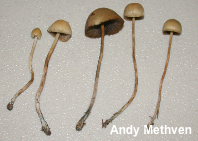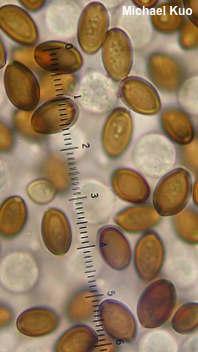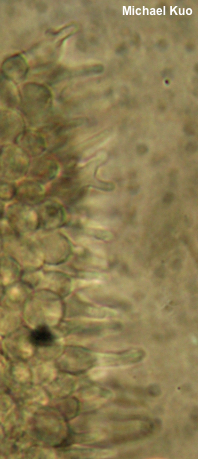| Major Groups > Gilled Mushrooms > Dark-Spored > Psilocybe > Psilocybe strictipes |

|
[ Basidiomycota > Agaricales > Strophariaceae > Psilocybe . . . ] Psilocybe strictipes by Michael Kuo, 31 October 2022 Distinguishing features for Psilocybe strictipes include its habitat in grass, its bluing stem base, its convex (rather than conical) cap, and its proportionally long stem, which lacks a ring or ring zone. Microscopic features, which should probably be consulted for identification, include spores measuring under about 12 µm in length, and a lack of pleurocystidia. Psilocybe semilanceata is a very similar, better-known species, separated by its more conical cap and its larger spores. Watling & Gregory (1987) speculate that Psilocybe strictipes is often erroneously labeled as Psilocybe semilanceata. At the other end of the spectrum, Læssøe & Petersen (2019) express doubt that the two species are truly distinct. Psilocybe callosa in the sense of many authors (including Guzmán 1983) is a synonym. Thanks to Andy Methven for facilitating study of Psilocybe strictipes. Description: Ecology: Saprobic; growing gregariously in lawns and meadows, or occasionally in forests; originally described from Britain (Cooke 1881, as Psilocybe semilanceata caerulescens); possibly distributed throughout Europe and North America (especially in the Pacific Northwest); also recorded from Chile. The illustrated and described collection is from North Carolina. Cap: 1–2 cm across; convex to broadly bell-shaped at first, becoming broadly convex; sticky when fresh, but soon dry; bald; pale tan to buff; hygrophanous; becoming finely grooved or lined near the margin; when young with a few fibrils from the partial veil along the margin. Gills: Broadly attached to the stem; close or nearly distant; short-gills frequent; pale brown when young, becoming purplish brown with whitish edges. Stem: 4–6 cm long; 1–2 mm thick; equal; dry; bald above, becoming finely fuzzy toward the base; pale brown; bruising blue near the base where handled; without a ring or ring zone after the veil breaks; basal mycelium white before bluing. Flesh: Whitish; unchanging when sliced. Odor and Taste: Not distinctive. Spore Print: Purplish brown (Guzmán 1983). Microscopic Features: Spores 8–11 x 5–7 µm; ellipsoid; smooth; with a large (1 µm) pore; walls 1 µm thick; brown in KOH. Basidia 25–28 x 6–8 µm; 4-sterigmate. Pleurocystidia not found. Cheilocystidia 25–35 x 5–10 µm; lageniform, with a long neck; occasionally bifurcated, with two necks; smooth; thin-walled; hyaline in KOH. Pileipellis a thin ixocutis of elements about 2.5 µm wide, above a layer of inflated cells 5–10 µ wide. Clamp connections present. REFERENCES: R. Singer & A. H. Smith, 1958. (Stamets, 1978; Smith, Smith & Weber, 1981; Guzmán, 1983; Moser, 1983; Watling & Gregory, 1987; Noordeloos, 1999; Borovička, 2008; Guzmán et al., 2008; Buczacki et al., 2013; Vesterholt, 2018; Læssøe & Petersen, 2019; Kibby, 2021.) Herb. Kuo 07172202. This site contains no information about the edibility or toxicity of mushrooms. |
© MushroomExpert.Com |
|
Cite this page as: Kuo, M. (2022, October). Psilocybe strictipes. Retrieved from the MushroomExpert.Com Web site: http://www.mushroomexpert.com/psilocybe_strictipes.html |


